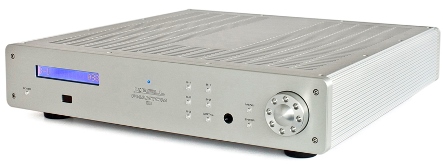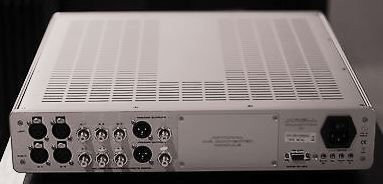The Krell Phantom III Preamplifier is a solid state, solidly built remote controlled preamplifier that carries a list price of $5,500. It has a zero-feedback dual-mono design and is available in anodized silver or black with an optional digital-to-analog converter (DAC) plug in board. The unit under review here does not have the DAC option.

The front panel includes a small florescent display that shows input selected and volume level. The display is both dimmable from the heavy metal remote control and unreadable from my listening seat which is about 30 degrees off axis since the system rack and shelves are on the side of my room. The front panel has buttons to select the input, a headphone jack, buttons for programming, and a large volume knob. The volume control knob requires about 10.5 full rotations to go from off to full volume.
There are two balanced inputs on XLR jacks, three unbalanced inputs on RCA jacks, and one each XLR and RCA outputs. For convenience and system compatibility, remote trigger in and out is also included on the back panel.
Other components on hand during the review period include a Basis 2500 Signature turntable with Vector 4 tonearm, Miyajima Kansui and Zu Audio DL-103R moving coil cartridges, Sutherland 20/20 and Sutherland DUO phono preamplifiers, Mark Levinson 326S preamplifier with phono, Ayre K-5xe MP preamplifier, Prism Orpheus Digital Interface and Lynx Hilo AD/DA converters with custom Windows 7 computer/music server, YG Acoustics Kipod II Signature Main Modules speakers, Magnepan 1.7 and 3.7 speakers, Dali Mentor 5 speakers (from the home theater system), and two Gallo TR-3 and TR-3D subwoofers. The power amplifier is the remarkable Acoustic Imagery Atsah monoblocks. All front end components receive their AC power from a PS Audio AV-5000 power conditioner, which is connected to the wall power with a Shunyata Anaconda CX power cord. A PS Audio Quintet, connected to the utility grid with another slithering Anaconda CX, is normally used for the power amplifiers. A variety of power cords are used elsewhere in the system, including Wyred4Sound P1 and Jerry’s DIY power cords which can be found on the music computer, Prism Orpheus, and Levinson preamp.
Now for the fun part where we tell you about the sound of the Krell preamp. Well, fun for you because you are (hopefully) spared long hours of listening to this product. In a nutshell, the Krell pre turns all music into mediocre MP3-quality sound. The soundstage has very little depth. Some left-to-right imaging is apparent. If you think about precise imaging where every performer occupies a very exact and delineated location on the sound stage in front of you, the Phantom III does not offer it. Performers blend into adjacent performers.
A good example is Paul Simon’s “Homeless” from the Graceland LP. The Ladysmith Black Mambazo singers, through either the Levinson 326S or Ayre K-5xe MP preamplifier, are arranged in an arc several feet behind Paul Simon. But through the Krell, everyone seems to be standing on a single straight line between the speakers.
Harmonic depth, which tells the listener about tone and emotion, is largely absent. This is consistent with low quality MP3-type low bit rate/low resolution character of sound. I thought of a beautiful woman with an IQ of room temperature. Let’s be kind and use the Fahrenheit scale. Sadly, there is simply not much there.
Listen to “The Race”, by Yello. This techno cut includes copious amounts of engineered special effects, including race cars speeding around the sound field and hand clapping. Through the Levinson 326S and the Ayre K-5xe MP, the sound space is huge, very deep, tall and wide. The Phantom III did passably well left to right, with good image centering. But depth was absent and the images of the musicians rarely approached believability.

The Phantom III is very dynamic and has an obviously high signal to noise ratio. The sound is virtually distortion free, scrubbed clean actually. The listening perspective is from the first section of the audience. The bass is good to very good with excellent control, if a little lacking in resolution.
During the review and audition period, I repeatedly switched between the Krell and Ayre preamplifiers. The Ayre lists for $3,500. There is no contest. The Ayre crushes the Krell preamp for $2,000 less. The Krell Phantom III might be fun for MP3 electronic techno music or recordings from AM radio since it does offer a big and dynamic sound. For anything else, look elsewhere.
Overall Rating: 2 LPs
